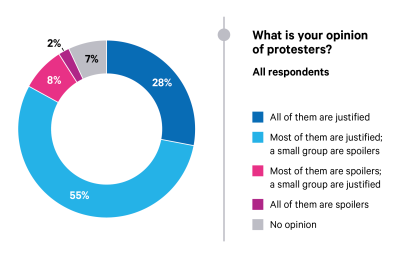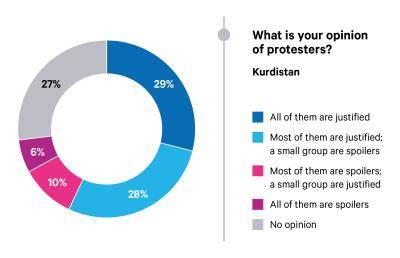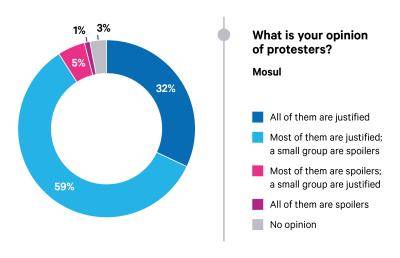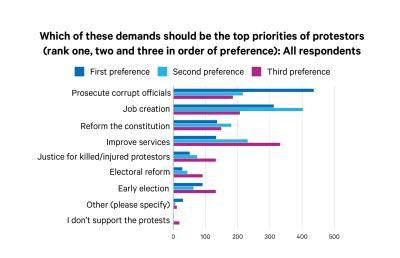Chatham House
|
|
Iraqi Views on Protesters One Year After the Uprising
Much analysis has been done of the motivations of Iraq's protesters, but how much support they have in the wider population has largely not been examined.
It is now one year since large-scale protests erupted across Iraq denouncing the endemic corruption, economic decline, and endless cycles of violent conflict that have marked the post-2003 system. To mark the anniversary, thousands of Iraqis returned to squares in Baghdad and across the south to air their ongoing grievances and to call for revolution against a political class that has failed them.
However, unlike in 2019 when protesters remained in place for months, this time they packed up their tents and went home. Over the past year, protest numbers have dwindled due to the coronavirus lockdown and more general protest fatigue. Some have expressed annoyance that the protests had been infiltrated by unknown groups; others speculate political parties are seeking to undermine them.
Many Iraqi politicians have played down the significance of the protests, dismissing them as the actions of a small number of disorganized movements with no coherent political aims. They point to the recent decline in numbers to argue that a growing ‘silent majority’ of Iraqis are uncomfortable with the protests’ demands and methods.
So how do most Iraqis feel about the protests? To better understand the views of the general population on the protest movement, Chatham House’s Iraq Initiative project commissioned a survey of more than 1,200 Iraqis. The responses suggest a large majority of the public are sympathetic to protests and share the same grievances against the current system, a finding supported by recent interviews and meetings.
Who supports the protests?
When asked for their opinion of protestors, 83 percent of respondents say either all of them were justified, or that most were justified, while only 10 percent feel either all or most of the protests were ‘spoilers’ (mukharabeen) – a word that some elites have used to discredit protesters.

Source: Survey conducted by IIACSS in July 2020 commissioned by Chatham House Middle East and North Africa Programme
A majority of respondents in all regions support all or most of the protestors, even the semi-autonomous Kurdistan region where citizens can tend to feel removed from events in the rest of Iraq. Even in those provinces liberated from ISIS but still under the precarious control of various armed groups, where locals have not protested for fear of repercussions, public support remains high. In Mosul for instance, 91 percent believe that protests were either all or mostly justified.

Source: Survey conducted by IIACSS in July 2020 commissioned by Chatham House Middle East and North Africa Programme

Source: Survey conducted by IIACSS in July 2020 commissioned by Chatham House Middle East and North Africa Programme
Although a majority of protestors are known to be young and either unemployed or in education, the survey responses suggest widespread support that transcends societal divisions by age, employment status, gender, or income. Male and female responses are similar with 88 percent and 86 percent respectively viewing protesters as all or mostly justified, although women offer more unqualified support at 33 percent to male respondents’ 22 percent.
Those aged 25 or younger are the most supportive age group but by only a very slender margin. Many over 40 offer a supportive view with 87 percent saying protests are all or mostly justified, indicating that a strong desire for change is not limited to those who have never known a different political system to the current one.
Students offer the most positive view on protesters, but there is only a marginal difference between responses of students and those employed full-time. Differences between the responses of those in different income brackets are similarly small.
Protest priorities
The survey also asked respondents what the protesters’ top three demands of the government should be. Nationally, the tackling of corruption in government is the most popular demand, followed by job creation and improvements to service provision third, and this is the case in the majority of individual provinces. Kirkuk is the only area where respondents prioritize improvement to services over either corruption or job creation – not surprising given that Kirkuk suffers an acutely severe humanitarian situation, particularly in the poorer southern parts of the province.

Source: Survey conducted by IIACSS in July 2020 commissioned by Chatham House Middle East and North Africa Programme
Interestingly, across all regions, genders, and ages, electoral reform and early elections feature low down the list of priorities in the eyes of the general public – although it is worth noting that the majority of the survey was carried out in July, before early elections were proposed. Prime Minister al Kadhimi has bet much of his political capital on pushing an electoral reform bill through parliament and holding early elections on 6 June 2021 – and yet the data indicates this is not seen as a crucial priority by a majority of the public.
Certainly there has been a significant degree of scepticism that electoral reform can be achieved in time for June 2021 and, as a forthcoming Chatham House paper argues, past attempts at electoral reform in 2005 and 2013 achieved very little. This may explain why, although early elections were initially a key demand of the protest movement, it seems most of the population would prefer the government to focus on reforms which target corruption instead of elections which reinforce the same system and elite.
Implications for 2021 elections
Should the protest movements be able to successfully organize into one or more political parties or blocs and compete for parliamentary seats, such a high level of public support could translate to significant electoral gains. Only 20 percent of Iraqis voted in 2018, meaning most of the electorate remain outside the patronage networks that reinforce the post-2003 political parties.
But efforts to mobilize the protests into a single coherent group have failed so far, and they remain a disparate mass of smaller movements. The ‘October Revolution’ is still understood best as a backlash to decades of trauma and poor governance, rather than as a top-down political movement, making it unlikely a single party or group can successfully convert public support for direct action into actual political change.
Dwindling numbers in Baghdad’s Tahrir Square lead many to conclude the protests have run their course, but this survey highlights the majority of citizens remain disillusioned with the political system and are overwhelmingly supportive of protesters, regardless of the criticism levelled at them by those who benefit from the status quo.
Iraq remains a far cry from the prosperity and democracy promised in 2003, and neither the government crackdown nor any quick-fix solution – such as a fresh election – will alleviate the long-standing grievances in Iraqi society that look to simmer until the next trigger.
For this nationally representative survey 1,217 computer-assisted face-to-face interviews were conducted by the Independent Institute of Administration and Civil Society Studies (IIACSS), which is the only representative body of GALLUP in Iraq.
The weighted sample reflects the demography of the population including on age, gender, education, geography, and urban/rural composition. Multi-stage cluster sampling was used as follows: probability proportional to size sampling at governorate, district, sub-district, and block level in urban areas; simple random sampling in rural areas at village selection, and house/individual level.
The survey was conducted in both Arabic and Kurdish; women enumerators interviewed women. The survey was fielded from 12 July to 9 August 2020 and, for this sample, the margin of error is 2.8, and a confidence interval of 95%.
Original article link: https://www.chathamhouse.org/2020/10/iraqi-views-protesters-one-year-after-uprising
 |
RESEARCH | EXPERTS | EVENTS | MEMBERSHIP | ACADEMY | ABOUT |


